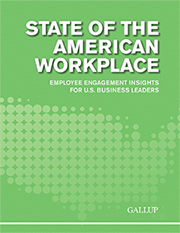The vast majority of U.S. workers, 70%, are "not engaged" or "actively disengaged" at work, meaning they are emotionally disconnected from their workplace and are less likely to be productive. Actively disengaged employees alone cost the U.S. between $450 billion to $550 billion each year in lost productivity, and are more likely than engaged employees to steal from their companies, negatively influence their coworkers, miss workdays, and drive customers away.

These findings are from the State of the American Workplace: Employee Engagement Insights for U.S. Business Leaders report, which Gallup released today. This new report reveals the trend in U.S. employee engagement, the impact of engagement on organizational and individual performance, information about how companies can accelerate employee engagement, and insights into engagement across different segments of the U.S. working population.
Key findings from the report include:
- Work units in the top 25% of Gallup's employee engagement database have significantly higher productivity, profitability, and customer ratings, less turnover and absenteeism, and fewer safety incidents than those in the bottom 25%.
- Managers who focus on their employees' strengths can practically eliminate active disengagement and double the average of U.S. workers who are engaged nationwide.
- The generations at the beginning and approaching the end of their careers tend to be more engaged than those in the middle of their careers.
- Although certain policies such as hours worked, flextime, and vacation time do relate to employee well-being, engagement levels in the work environment eclipse corporate policies.
- Despite not having a manager nearby to monitor their productivity, remote workers actually log more hours at their primary job than do their on-site counterparts.
- Only 41% of employees felt that they know what their company stands for and what makes its brand different from its competitors' brands.
- Engagement levels among service employees -- those workers who are often on the front line serving customers -- are among the lowest of any occupation Gallup measured and have declined in recent years, while engagement for every other job category increased.
For more insights and to learn what your company can do to improve employee engagement, read the State of the American Workplace report and visit the Employee Engagement area on this site.
Join the conversation on Twitter: #EmployeeEngagement.
